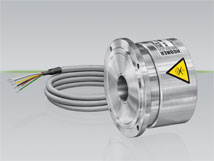


| 型号: | ACC 70 • ACC 74 |
| 类别: | ACC 70 • ACC 74 |
| 描述: | Speed-controlled drives are subject to ever increasing demands with regard to dynamics, smooth running and disturbance resistance. Relative acceleration sensors on the Ferraris principle perform sterling service when it is necessary to analyze drive systems in order to improve the quality of the system as a whole. Furthermore, if the sensors are incorporated into the control loop, then the control-loop performance can be considerably improved. Functional principle (after Galileo Ferraris) Permanent magnets mounted in the fixed detector unit induce eddy currents in the moving, conductive, but non-magnetic bell-shaped rotor. The eddy currents and the magnetic fields that they generate are proportional to the radial velocity of the rotor. A change in the eddy current produces a voltage in the coils mounted in the detector unit that is proportional to the rate of change of the angular velocity, i.e. proportional to the angular acceleration. Fields of application for the Ferraris-Sensor System analysis: vibration analysis smooth-running test identification of mechanical parameters (mass, moment of inertia, damping) reconstruction of force, torque and friction detection of the causes of unwanted noise monitoring motors and bearings measuring frequency response. Increasing the control-loop performance If the Ferraris sensor is integrated in the P-PI control loop, then the dynamics, disturbance resistance and smoothness of the drive can be significantly improved. In this way, the resulting quietness of the system also reduces the wear on mechanical components, prevents the generation of unwanted noise, and reduces the power loss in the motor. • • • • • • • Special features: relative, contactless, active measurement principle mechanically rigid construction, no coupling required high linearity and sensitivity no lower frequency limit, high bandwidth possible very low noise, inherently zero offset voltage no sensitivity orthogonal to measurement direction compact dimensions easy mounting and adaptation to existing fittings large permissible mounting tolerance no movable parts in the detector unit insensitive to dirt very robust, resistant to extreme shock loading |
[返回]
